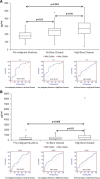Identification of proteins found to be significantly altered when comparing the serum proteome from Multiple Myeloma patients with varying degrees of bone disease
- PMID: 25322877
- PMCID: PMC4213504
- DOI: 10.1186/1471-2164-15-904
Identification of proteins found to be significantly altered when comparing the serum proteome from Multiple Myeloma patients with varying degrees of bone disease
Abstract
Background: Bone destruction is a feature of multiple myeloma, characterised by osteolytic bone destruction due to increased osteoclast activity and suppressed or absent osteoblast activity. Almost all multiple myeloma patients develop osteolytic bone lesions associated with severe and debilitating bone pain, pathologic fractures, hypercalcemia, and spinal cord compression, as well as increased mortality. Biomarkers of bone remodelling are used to identify disease characteristics that can help select the optimal management of patients. However, more accurate biomarkers are needed to effectively mirror the dynamics of bone disease activity.
Results: A label-free mass spectrometry-based strategy was employed for discovery phase analysis of fractionated patient serum samples associated with no or high bone disease. A number of proteins were identified which were statistically significantly correlated with bone disease, including enzymes, extracellular matrix glycoproteins, and components of the complement system.
Conclusions: Enzyme-linked immunosorbent assay of complement C4 and serum paraoxonase/arylesterase 1 indicated that these proteins were associated with high bone disease in a larger independent cohort of patient samples. These biomolecules may therefore be clinically useful in assessing the extent of bone disease.
Figures


Similar articles
-
High serum YKL-40 concentration is associated with severe bone disease in newly diagnosed multiple myeloma patients.Eur J Haematol. 2008 Apr;80(4):310-7. doi: 10.1111/j.1600-0609.2007.01027.x. Epub 2007 Dec 21. Eur J Haematol. 2008. PMID: 18182077
-
New agents in the Treatment of Myeloma Bone Disease.Calcif Tissue Int. 2018 Feb;102(2):196-209. doi: 10.1007/s00223-017-0351-7. Epub 2017 Nov 2. Calcif Tissue Int. 2018. PMID: 29098361 Free PMC article. Review.
-
[Bone disease in multiple myeloma].Nihon Rinsho. 2015 Jan;73(1):42-6. Nihon Rinsho. 2015. PMID: 25626302 Japanese.
-
Therapeutic options in the management of myeloma bone disease.Semin Oncol. 2010 Jun;37 Suppl 1:S20-9. doi: 10.1053/j.seminoncol.2010.06.009. Semin Oncol. 2010. PMID: 20682368 Review.
-
[Management of multiple myeloma-related bone disease].Przegl Lek. 2013;70(11):950-7. Przegl Lek. 2013. PMID: 24697037 Review. Polish.
Cited by
-
Protein Digestion for 2D-DIGE Analysis.Methods Mol Biol. 2023;2596:339-349. doi: 10.1007/978-1-0716-2831-7_23. Methods Mol Biol. 2023. PMID: 36378449
-
Variability of serum novel serum peptide biomarkers correlates with the disease states of multiple myeloma.Clin Proteomics. 2019 Apr 23;16:17. doi: 10.1186/s12014-019-9238-0. eCollection 2019. Clin Proteomics. 2019. PMID: 31043929 Free PMC article.
-
Proteomic analysis of bronchoalveolar lavage fluid (BALF) from lung cancer patients using label-free mass spectrometry.BBA Clin. 2017 Mar 6;7:97-104. doi: 10.1016/j.bbacli.2017.03.001. eCollection 2017 Jun. BBA Clin. 2017. PMID: 28331811 Free PMC article.
-
Complement C3a activates osteoclasts by regulating the PI3K/PDK1/SGK3 pathway in patients with multiple myeloma.Cancer Biol Med. 2021 May 7;18(3):721-33. doi: 10.20892/j.issn.2095-3941.2020.0430. Cancer Biol Med. 2021. PMID: 33960177 Free PMC article.
-
Using Proteomics Data to Identify Personalized Treatments in Multiple Myeloma: A Machine Learning Approach.Int J Mol Sci. 2023 Oct 25;24(21):15570. doi: 10.3390/ijms242115570. Int J Mol Sci. 2023. PMID: 37958554 Free PMC article.
References
-
- Zamagni E, Cavo M. The role of imaging techniques in the management of multiple myeloma. Br J Haematol. 2012;159(5):499–513. - PubMed
Publication types
MeSH terms
Substances
LinkOut - more resources
Full Text Sources
Other Literature Sources
Medical
Miscellaneous

